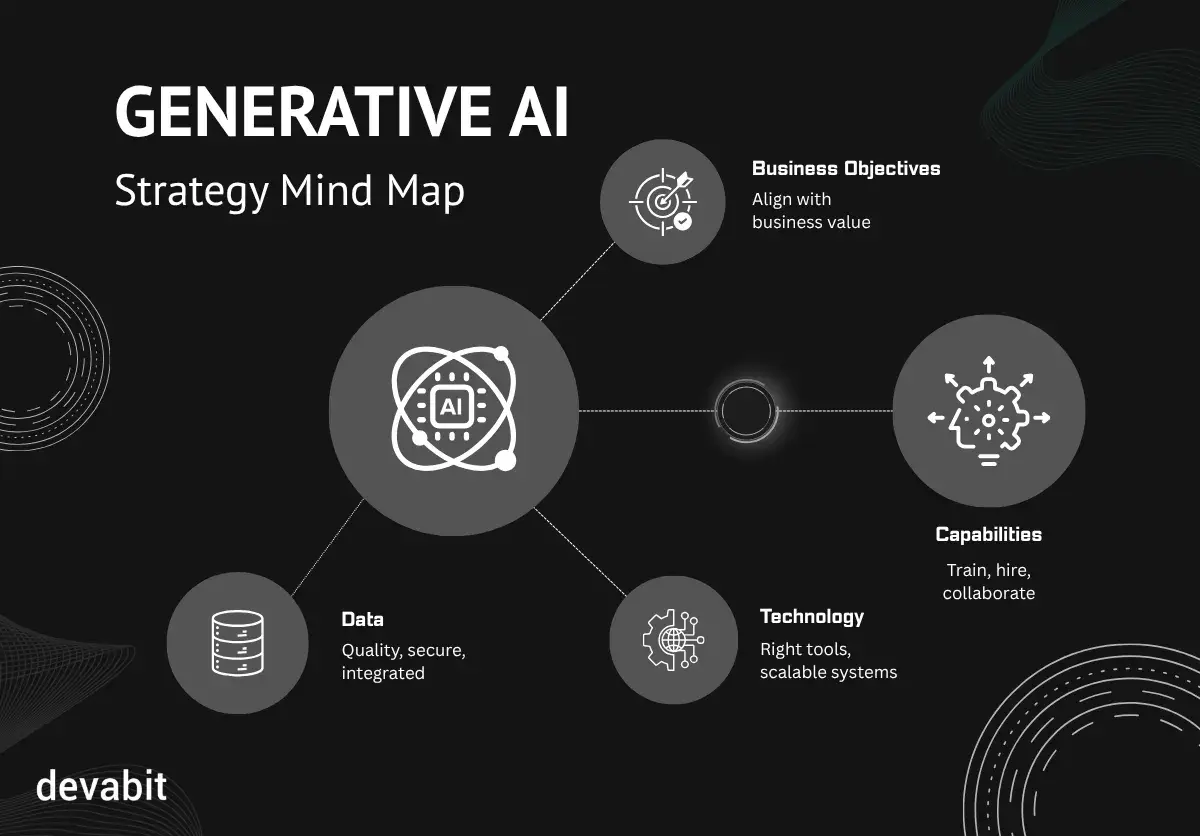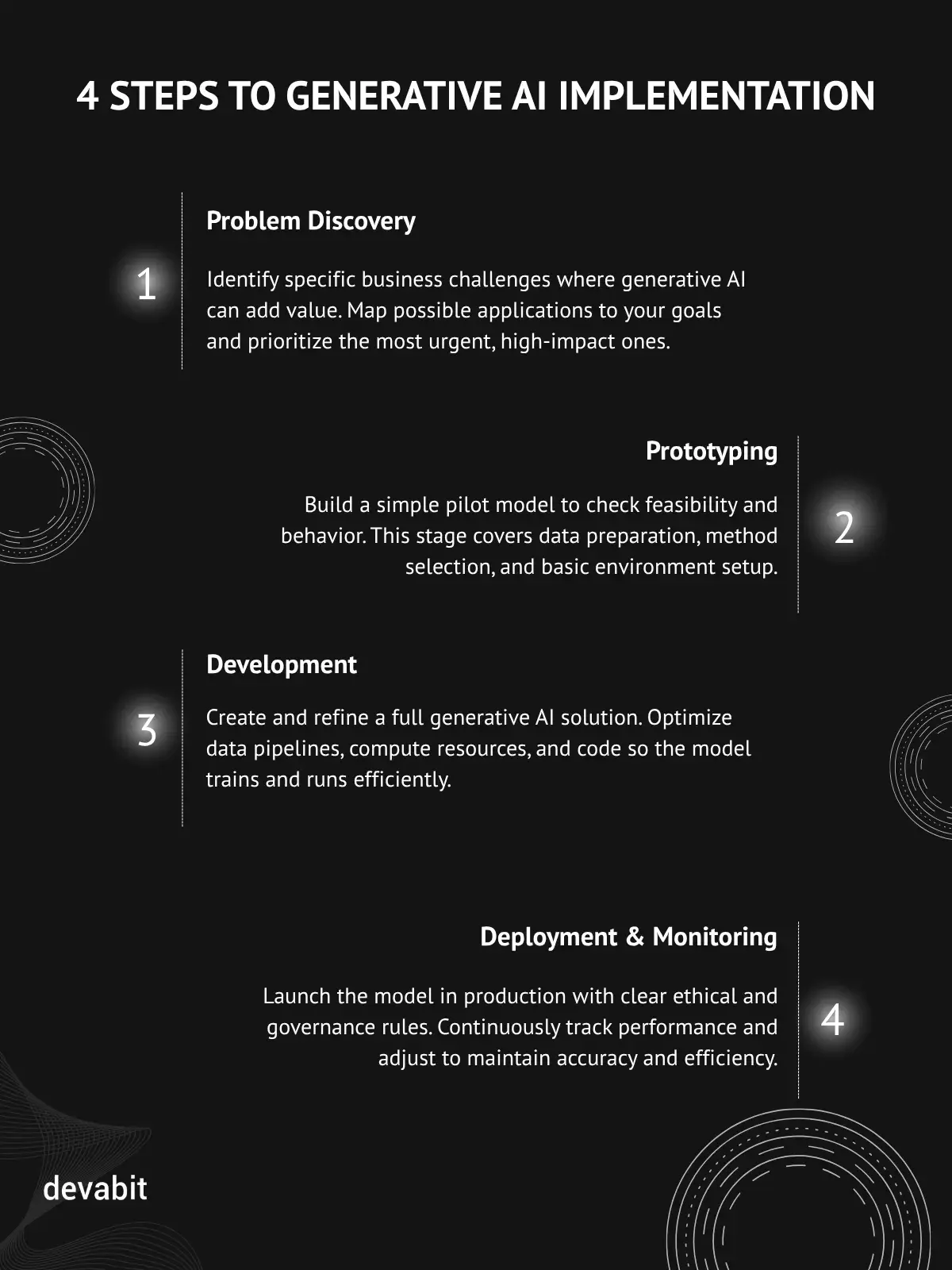Generative AI Implementation 101: Exclusive Tips & Tricks (+ BONUS: Gen-AI Secret)
Generative AI implementation, which stands for adopting the power of generative artificial intelligence, has revolutionized the way people comprehend the capabilities of machines. Going far beyond completing "intelligent" tasks like verifying theorems and playing chess, generative AI has overpowered the limits of generally accepted AI potential. While Internet users struggle to find out whether the video or image they see online is real or AI-generated (fun challenge: How do you think AI or a real person wrote this text?), businesses perceive generative AI as a great tool to save time and efforts on creating original content, automating complex processes, and generating fresh ideas. In just a couple of years, generative AI has undergone a lifetime path from being a weird innovation to a buzzword everyone uses. Yet, do you know what truly stands behind the concept of generative AI? All in all, can everyone implement generative AI? Our comprehensive generative AI implementation guide focuses on the key intricacies of generative AI implementation while also focusing on its true meaning, history, and more.
P.S. Read till the end and be the first to reveal the BONUS GEN-AI SECRET!
In short, here are the key insights we explore in today's article:
- Generative AI — the type of artificial intelligence responsible for creating various types of content, ranging from images to code.
- Generative AI works thanks to several machine learning models like Generative Adversarial Networks (GANs), Variational Autoencoders (VAEs), and Transformers.
- The generative AI market has a CAGR of 36.3% (2024-2030).
- How to implement Generative AI? Choose the right toolkit, consider feature engineering and normalization, utilize Dropout and L2 Regularization techniques, conduct Frechet Inception Distance (FID) and Perceptual Quality measurements, and take a look at pruning, quantization, and knowledge distillation techniques.

What Is Generative AI and Why Does It Matter for Modern Business?
Just a quick sneak peek into generative AI to sort things out.
Explaining the Concept of Generative AI
So, what is generative AI? The title of generative AI actually speaks for itself: it is all about generating content. Aimed at creating various types of digital content like images, music, software code, text, etc., generative AI is a deep-learning model that transforms raw data into the digital content you need. Leveraging all data accessible in the modern online environment, generative AI learns and interprets them to provide statistically probable outputs. Simply stated, generative AI is like a real assistant or analyst with unlimited access to all available resources. It investigates them in minutes instead of months to deliver a unique answer to your specific request. Sounds impressive, right?
How Does Generative AI Work?
In a nutshell, the performance of generative AI is based on various machine learning models like Generative Adversarial Networks (GANs), Variational Autoencoders (VAEs), and Transformers. Generative AI utilizes them to generate new data from patterns learned using existing datasets. When it comes to GANs, there are two neural networks you should know about: a generator and a discriminator. During the whole process, they compete in a battle where the generator tries to create realistic data. On the flip side, the discriminator works on revealing differences between the real and generated data, refining the whole output. VAEs, in turn, encode data into a lower-dimensional latent space. Then, it decodes data to create new data adjusted to the user's request. By way of illustration, transformer-based models, such as GPT, utilize attention mechanisms to extract the context out of data sequences, generating coherent and contextually relevant text. Trained on large databases, these models generate digital content that is nearly identical to real-world data.
Generative AI Implementation from the Business Perspective
Speaking of Generative AI in the business domain, it definitely gains momentum. With a CAGR of 36.3% (2024-2030), generative AI is going to remain a key innovation of the decade, motivating businesses to turn to generative AI implementation sooner or later. However, why is it so popular? After all, does it really offer something so exclusive that businesses queue up to implement generative AI? Well, the answer is simple: yes, it does. Let us take a look at several representative examples to illustrate this phenomenon.

Generative AI Implementation: External Business Value Example
Suppose you want to add a blog section to your website. Although writing articles and creating visual content like infographics do not refer to your key business competencies, you think having a blog section can positively impact brand awareness. Great, at this point, you have two possible solutions. First, you can hire an in-house or dedicated team of designers and content writers. As a result, you will get high-quality digital content to fill your blog section and raise brand awareness. At the same time, you must invest a lot of time, effort, and money. The section option is simple and, most importantly, completely free: you can use generative AI. Sure, it is essential to remember that AI-generated content has worse quality. Still, it is completely fine if creating a blog section is just an additional initiative, not a key brand representation tool. Hence, the verdict is obvious: generative AI wins this competition, saving time, money, and effort while allowing you to get more people to know about your brand.
Generative AI Implementation: Internal Business Value Example
In addition to providing outward-facing content, generative AI can be beneficial in terms of internal business operations. For example, your company deals with large volumes of customer support inquiries, technical documents, or internal communication. Such a vast amount of data requires quick response times and consistent messaging, and a large department of skilled professionals is also required to handle it properly. Luckily, you have nothing to worry about with generative AI. Leveraging AI-powered chatbots, natural language processing (NLP) tools, and text generators, you can automate these processes in a blink of an eye. Generative AI enables your business to analyze customer queries, generate accurate responses, and even provide personalized solutions in real time. Subsequently, generative AI is a perfect way to improve internal productivity while reducing costs associated with human labor.

Generative AI Implementation Cheat Code: 5 Practices & Tips to Succeed in 2026
Here we go: it is finally the right time to introduce our exclusive selection of the top generative AI implementation strategies. Ready, set... Let us crush it together!
1. It Is All About the Right Toolkit
Whether you want to develop a web platform or consider generative AI implementation, everything starts with choosing the right tech stack/tool/framework. While the modern market offers a wide selection of available AI development platforms, business owners are confused by the number of options. Fortunately, the choice is easy when you understand your needs and the desired outcome.
Meanwhile, devabit recommends the following generative AI implementation tools:
- Hugging Face
- Transformers
- GAN Lab

As one of the most widely used generative AI implementation tools, Hugging Face offers a wide array of pre-trained models and tools for NLP tasks, including GPT-based models. In case you are looking for a text generation and language translation tool, Hugging Face is your top choice. GAN Lab, in turn, serves as a visual and interactive tool for learning about GANs. It is a perfect option for those who want to gain a deep understanding of interactions between the generator and discriminator, especially if you are new to generative AI.
2. Forewarned is Forearmed: The Role of Preprocessing in Generative AI Implementation
It is not a secret that data is a cornerstone of each AI model. Accordingly, the quality of data defines the future performance of generative AI solutions. In this regard, data collection and preprocessing are pivotal in ensuring the proper functioning of generating AI. To ensure preprocessing goes smoothly, devabit recommends using diverse and representative data sets. This technique helps to ensure the model generalizes well to new data. Over and above that, using data augmentation techniques to artificially increase the size and variety of your dataset (e.g., image flipping, rotation, etc.) can be a great solution for small data sets.
Regarding preprocessing tips, there is no better advice than normalization. It helps to speed up the convergence of the learning process. On the other hand, do not forget about feature engineering. As a crucial step of generative AI implementation, this technique helps emphasize critical data features that the model should focus on. As a result, it also improves AI's learning capabilities.

3. Measure Twice, Cut Once or Why Repeatable Training Works
A good generative AI model is like a student. It requires repeatable training to polish its knowledge to perfection. Thus, training is an inseparable part of generative AI implementation. Thanks to training, you not only can optimize AI's performance but also gain the ability to prevent issues like mode collapse.
Here are several advanced generative AI implementation and training tips you should stay aware of. First, remember about regularization. By way of illustration, Dropout and L2 Regularization techniques can be utilized to ensure the model learns instead of just memorizing training data. In case you are seeking better convergence, learning rate scheduling is an option. Pro tip: To avoid sticking to local minima, regulate the learning rate by gradually decreasing it.
When it comes to GAN-specific generative AI implementation strategies, label smoothing and progressive growing are at the top of the list. On the one hand, label smoothing helps to prevent the discriminator from becoming too overpowering by softening the labels for the discriminator. On the other hand, progressive growing ensures the model is aware of fundamental patterns before proceeding to more complex ones. For instance, it works well with complex data like high-resolution images. Just train the model with smaller images, gradually increasing their size.
4. It Is Time to Measure the Result
There is no doubt that evaluating AI in terms of generative AI implementation is more nuanced than assessing traditional machine learning models. While quantitive metrics can be inefficient here, Frechet Inception Distance (FID) and Perceptual Quality measurement are real game changers. Estimating the distance between the distributions of generated data and real data, a low FID score implies high data quality. On the flip side, nothing can beat human judgment, so it would be a great idea to consider integrating visual inspection or user studies as a part of your generative AI implementation process.
After all is said and done, it is time to fine-tune your model. Do not skip this generative AI implementation step since it may be useful for enhancing the model's accuracy and generation capabilities and saving training time and resources. For example, you can fine-tune hyperparameters like learning rate or batch size while also fine-tuning a pre-trained model for your specific task.
5. Final Step of Generative AI Implementation: From Model to Market
At the end of the day, when your generative AI model is perfectly trained and fine-tuned, it is time to introduce it to the world. Here, deployment comes into play. It is essential to optimize your model for production so you can be confident it functions properly in real-world circumstances. Take a look at pruning, quantization, and knowledge distillation techniques. They can be extremely useful to reduce the model's size without compromising its performance so that your model can be easily deployed on devices with limited resources. If you lack scalability, consider using cloud-based platforms like AWS, Azure, or Google Cloud to deploy your model.

As we move to the final stage of generative AI implementation, integration considerations are essential. Develop API to ensure your model can be easily integrated with other apps. Finally, put an emphasis on real-time performance. This phase is crucial to ensure your model can handle real-time data and generate quick responses.
11 New Technologies in AI
Since we have already sorted out what the true meaning and business value of generative AI implementation is, it is time to take a look at the key AI trends that will shape the generative AI market during the following years. Ready to dive in?
01 / The Evolution of ChatGPT. From the first introduction of GPT-1 in 2018 to next-gen features like content generation, customer support, and virtual assistants enabled by GPT-4 and ChatGPT store, ChatGPT evolves at a rapid pace, bringing more and more astonishing features to the table.
02 / The Rise of Explainable AI (XAI). The impressive mesh of decision trees, linear models, and rule-based systems provides insights into how a model makes predictions, making XAI one of the most promising AI trends of the decade.
03 / Predictive AI Analytics. Taking the best from data science, machine learning, and statistical modeling, predictive AI analytics signifies the new era in marketing personalization, enabling businesses to analyze customer behavior and preferences and deliver personalized content.
04 / Custom Healthcare AI Solutions. From AI medical imaging to an AI-powered telehealth platform, the adoption of AI in healthcare is a new trend that has received controversial reviews. On the one hand, there is a successful case: an AI model achieved 94% accuracy in detecting breast cancer in mammograms. On the other hand, the healthcare sector is a vulnerable area that requires additional regulations when it comes to the application of AI.
Interested in AI trends? Click here to access the complete overview of 11 emerging AI trends.

BONUS Paragraph: Generative AI Secret & Conspiracy Theory Revealed!
Hooray to all generative AI implementation explorers! It is time to unveil the hidden traits of generative AI you have never heard about.
Latent space manipulation. Wait, what is latent space, and who manipulates it? Let us explain everything from A to Z. Latent space is an abstract multidimensional concept utilized to represent the data within the model. Simply stated, perceive it as the model's imagination. True magic happens when people figure out how to navigate and manipulate this latent space. Although mastering manipulation is not good advice when we talk about the relationships between people, it can be a beneficial practice when it comes to AI. On the one hand, mastering the art of latent space manipulation can lead to the development of AI systems that create not just random or generic content but highly tailored, purposeful outputs. On the other hand, free generative AI models used by billions of users daily can also be manipulated by someone... Well, this is how we proceed to the generative AI conspiracy theory.

According to this theory, tech giants and governments (Masons??) shape reality itself through AI-generated content. By manipulating the advanced AI algorithms we are familiar with (GPT models and deepfake technologies), they subtly control public opinion, exploit narratives, and even rewrite history. Adherents of this theory believe that AI-generated content is strategically used to distract, trick, and guide society toward a controlled perception of reality — one that aligns with the hidden plans of powerful entities. All in all, there is no solid proof to support these claims, so it is only up to you to believe in them or not.
Final Thoughts on Generative AI Implementation
Hopefully, you have managed to find the grail of truth in the world of generative AI secrets and conspiracy theories. Returning to the subject of our topic, we believe that utilizing the right generative AI implementation strategies is the key to success. From choosing the proper generative AI implementation toolkit to establishing an efficient training process, each tiny step matters on the way to excellent outcomes.

Interested in AI technology but do not know where to start? Fortunately, we are here to help. At devabit, we leverage the full potential of AI to help our clients lead the competition. Moreover, we provide dedicated teams of engineers proficient in web/mobile development, cloud development, 3D modeling, and BPO. Ready to make the first step toward an AI-powered future? Contact us right now, and we will assist you every step of the way to your success.
Recent Publications
Don't miss out! Click here to stay in touch.
Interested in AI?

Relevant Articles View all categories
View all categories CONNECT WITH US WE’RE READY
TO TALK OPPORTUNITIES
THANK YOU! WE RECEIVED YOUR MESSAGE.
Sorry
something went wrong



